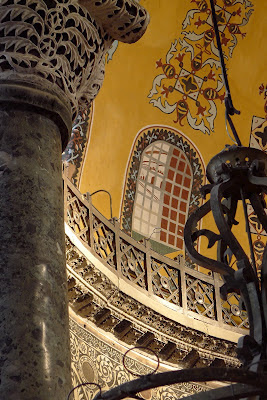Since I wasn't able to take pictures on my last field trip, I am posting far too many from my trip yesterday. Dr. Magdalino took the Constantinople class to Sultanahmet (the area of old Constantiople) to view the Archaeology Museum, Hagia Sophia, and the Hippodrome. The later two date from the early Byzantine Empire and of course the Archaeology Museum holds even more artifacts from that era. By the time we reached the Hippodrome I was plum tuckered out- and thus no pictures. Enjoy!


 Strange beast which was probably mounted on a secular building. The tail is that of a peacock.
Strange beast which was probably mounted on a secular building. The tail is that of a peacock.
 Dr. Magdalino explaining a relief.
Dr. Magdalino explaining a relief.
 Some stylized Greek from Late Byzantium. And no, I cannot read it at this point.
Some stylized Greek from Late Byzantium. And no, I cannot read it at this point.
 This foot, or rather heal has an interesting story. It is from a statue of the tetrarchs which is currently in Venice (stolen in the 4th Crusade). The heel is the only piece still in Turkey and helped to identify the original location of the statue. http://en.wikipedia.org/wiki/Portrait_of_the_Four_Tetrarchs
This foot, or rather heal has an interesting story. It is from a statue of the tetrarchs which is currently in Venice (stolen in the 4th Crusade). The heel is the only piece still in Turkey and helped to identify the original location of the statue. http://en.wikipedia.org/wiki/Portrait_of_the_Four_Tetrarchs
 Another piece of porphyry (a knowingly difficult stone to carve). It is suspected that this might have adorned the sarcophagus of Constantine the Great. Either way it is definitely imperial.
Another piece of porphyry (a knowingly difficult stone to carve). It is suspected that this might have adorned the sarcophagus of Constantine the Great. Either way it is definitely imperial.
 Ceramics dating from early Byzantium. In a class last Thursday I was able to handle similar shards. The ones I looked at in class were 11-12th C. Too cool.
Ceramics dating from early Byzantium. In a class last Thursday I was able to handle similar shards. The ones I looked at in class were 11-12th C. Too cool.
 A well preserved icon with inlay.
A well preserved icon with inlay.
 A rare bicolored marble statue.
A rare bicolored marble statue.
 Sarcophagi thought to belong to Constantine the Great and his family. It cannot be tested, but they were found in the Church of the Holy Apostles where Constantine was buried. Again, the porphyry is a stone used in important sculptures and works because of its tough nature.
Sarcophagi thought to belong to Constantine the Great and his family. It cannot be tested, but they were found in the Church of the Holy Apostles where Constantine was buried. Again, the porphyry is a stone used in important sculptures and works because of its tough nature.
 Looking at the ruins of the Byzantine hospital adjacent to Hagia Eirene.
Looking at the ruins of the Byzantine hospital adjacent to Hagia Eirene.
 Hagia Sophia- and people!
Hagia Sophia- and people!








 Strange beast which was probably mounted on a secular building. The tail is that of a peacock.
Strange beast which was probably mounted on a secular building. The tail is that of a peacock.
 Dr. Magdalino explaining a relief.
Dr. Magdalino explaining a relief.
 Some stylized Greek from Late Byzantium. And no, I cannot read it at this point.
Some stylized Greek from Late Byzantium. And no, I cannot read it at this point.
 This foot, or rather heal has an interesting story. It is from a statue of the tetrarchs which is currently in Venice (stolen in the 4th Crusade). The heel is the only piece still in Turkey and helped to identify the original location of the statue. http://en.wikipedia.org/wiki/Portrait_of_the_Four_Tetrarchs
This foot, or rather heal has an interesting story. It is from a statue of the tetrarchs which is currently in Venice (stolen in the 4th Crusade). The heel is the only piece still in Turkey and helped to identify the original location of the statue. http://en.wikipedia.org/wiki/Portrait_of_the_Four_Tetrarchs
 Another piece of porphyry (a knowingly difficult stone to carve). It is suspected that this might have adorned the sarcophagus of Constantine the Great. Either way it is definitely imperial.
Another piece of porphyry (a knowingly difficult stone to carve). It is suspected that this might have adorned the sarcophagus of Constantine the Great. Either way it is definitely imperial.
 Ceramics dating from early Byzantium. In a class last Thursday I was able to handle similar shards. The ones I looked at in class were 11-12th C. Too cool.
Ceramics dating from early Byzantium. In a class last Thursday I was able to handle similar shards. The ones I looked at in class were 11-12th C. Too cool.
 A well preserved icon with inlay.
A well preserved icon with inlay.
 A rare bicolored marble statue.
A rare bicolored marble statue.
 Sarcophagi thought to belong to Constantine the Great and his family. It cannot be tested, but they were found in the Church of the Holy Apostles where Constantine was buried. Again, the porphyry is a stone used in important sculptures and works because of its tough nature.
Sarcophagi thought to belong to Constantine the Great and his family. It cannot be tested, but they were found in the Church of the Holy Apostles where Constantine was buried. Again, the porphyry is a stone used in important sculptures and works because of its tough nature.
 Looking at the ruins of the Byzantine hospital adjacent to Hagia Eirene.
Looking at the ruins of the Byzantine hospital adjacent to Hagia Eirene.
 Hagia Sophia- and people!
Hagia Sophia- and people!






Comments